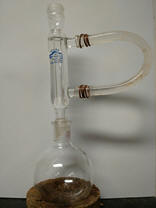
Last updated
1. General
Review the following topics: Infrared Spectroscopy, NMR Spectroscopy, UV-Vis Spectroscopy, Polarimetry
Don't forget to start working on your formal report. By now, you should be able to write an introduction that contains an alternate synthesis for the salicylic aldehyde prepared in the lab and chiral epoxides. The draft version of the paper is due by January 22, 2016 by 4:30 pm in YH 3077E.
2. Experiment
a. Jacobsen Ligand
The tartrate salt and the potassium carbonate has to be dissolved completely before the aldehyde is added. This is very important to avoid possible side reactions i.e., deprotonation of the phenol, which will make the aldehyde a weaker electrophile due the resonance with the negative charge of the phenolate.
If you have to downscale the reaction, it is imperative to downscale the amount of solvent as well because the ligand displays a moderate solubility in ethanol.
Make sure that you set the temperature to a gentle reflux and do not forget to stir the mixture. Note that reflux implies that the mixture is boiling and that a reflux ring is observed in the lower third of the condenser.

A reflux period of 45 minutes is usually sufficient to complete the reaction. Most of the time, a yellow precipitate is formed immediately. Thus, efficient stirring is needed to avoid bumping.
The crude ligand is dissolved with a mixture of ethyl acetate and hexane (1:1). About 20 mL of the solvent mixture is usually sufficient.
During the drying step, the washing procedure followed correctly: first water, then saturated sodium chloride solution and lastly the drying agent in the organic layer only (try to remove the aqueous layer as good as possible).
The students will have to use a rotary evaporator to remove the solvent. Video
Make sure to recover the entire ligand from the round-bottomed flask. If necessary, use a small amount of ethyl acetate to transfer the ligand into a small beaker, from which the solvent is removed by using an air stream.
For procedure how to use the polarimeter see last page of reader and link.
3. Thing to think about
a. Why is water added to the reaction mixture before it is allowed to cool down?
b. How many signals do you expect to see in the 13C{1H}-NMR spectrum of the ligand? In which ranges do they fall?
c. How does the polarimetric measurement help to establish the absolute configuration and purity of the ligand?
d. Which solvent is used for the polarimetry and the UV-Vis measurement? What are the proper concentrations for each measurement?